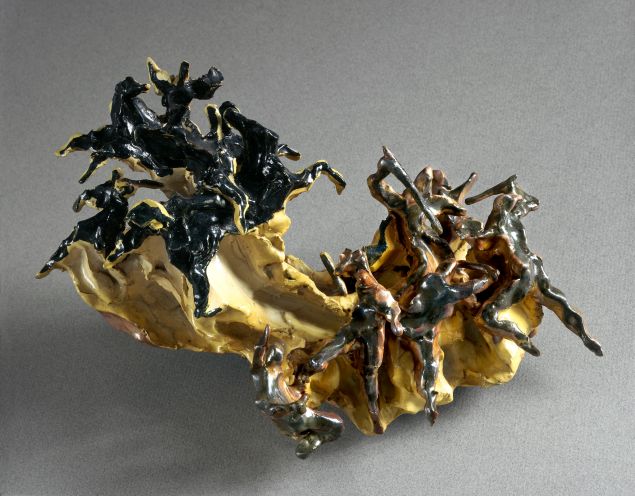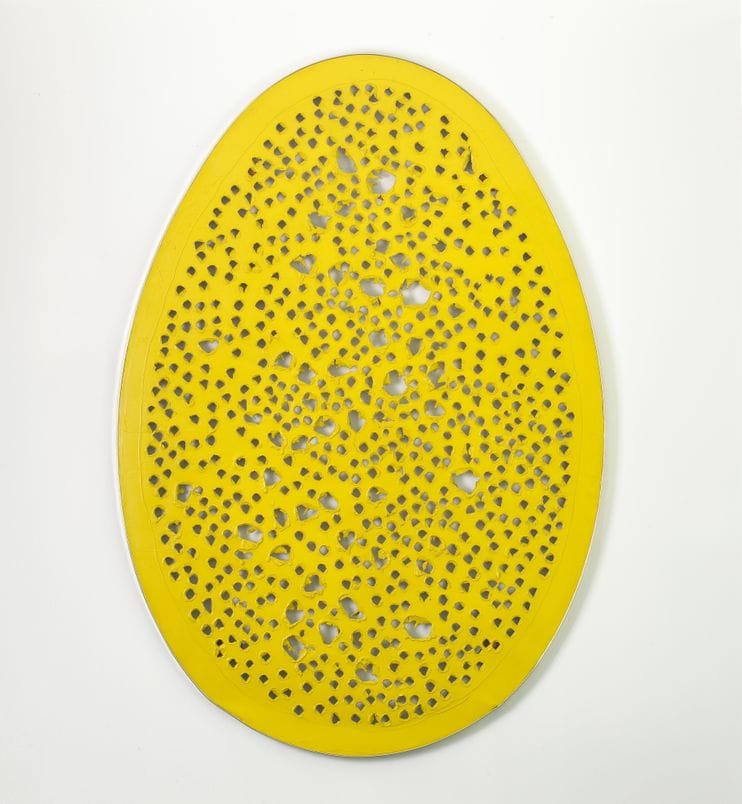Lucio Fontana's Feats of Clay
Published in Apollo, March 2019.
Was Lucio Fontana, at heart, just an easily distracted ceramist? So one might conclude from the artist’s current monographic exhibition at the Met Breuer. The show reveals him to be a chameleon figure, highly responsive to the prevailing winds of art and politics. He worked across numerous artistic disciplines, and successfully operated in contexts that should have been antithetical to one another, leaving an overall impression of adaptability shading into opportunism. The one through-line is his work in clay, which is often breathtaking in its radical conception.
Battle (Battaglia), 1947. Ceramic.
Fontana was born in 1899 in Rosario, Argentina. His Italian father was a sculptor and Fontana got his initial artistic training in his studio. He returned to Argentina often in his later life; one achievement of the Met’s exhibition is that it situates him in relation to contemporaneous Latin American modernism. Yet it was back in Italy that he made his decisive artistic moves, including in ceramics. His first experience with the medium was in 1930, when he created sculpture in terracotta, just after his studies at the Brera Academy of Fine Arts in Milan. Five years later, through a collaboration with the potter Tullio Mazzotti, he made his earliest significant works in clay: some impressively large but relatively conventional statuary and, more importantly, a series of vivid grotesques, nimbly poised at the intersection of figuration and abstraction, sometimes left as raw clay, sometimes sheathed in a carapace of shiny glaze.
These works reflect influences from the past – prehistoric artefacts, baroque architectural ornament, terracotta sketches by Bernini and Carpeaux – yet they also anticipate later developments in the medium, in particular the Expressionist works of Peter Voulkos and other Americans in the 1950s, and the Sodeisha group in Japan. Though smaller they also presage Willem de Kooning’s big bronze sculptures and the work of present-day sculptors working in ceramic, such as Arlene Shechet. Like these artists, Fontana arrived at sophisticated forms without losing touch with the immediacy of clay.
Perhaps if ceramics had not had such marginal status in Fontana’s day, he might have been content to concentrate on the medium, and establish himself as its consummate modern master. Instead, he directed his energies to other genres and projects. This avidity led him into thoughtless complicity with Mussolini’s regime, happy to complete monumental sculpture for the Fascists. In the Met’s exhibition catalogue, art historian Emily Braun concludes that ‘the blitheness of his performance might make us shudder’.
Spatial Environment in Red Light, 1967.
In the shadow of this ghastly misjudgment, Fontana’s avant garde posturing in the postwar era seems even more dubious than it otherwise might. As with his close colleague Yves Klein, there is an air of the mountebank about him: can we really believe this man? The question arises when reading the Manifiesto Blanco, a text which he published in Buenos Aires in 1946, supported by a group of other artists in the city. It is filled with dramatic claims, many of them borrowed from long-outmoded Futurism, others simply vague: “we need an art which is, of itself, valid; an art unsullied by our ideas.”
It’s almost impossible to connect such pronouncements to his actual artwork of these years, though some of it is fascinating – particularly his prescient experiments with luminescence and neon. The Met has reconstructed several of these ambienti spaziali – two at the Breuer, one at the main museum on Fifth Avenue, and a fourth in collaboration with El Museo del Barrio. These are fun to experience, as hundreds of Instagram photos out there attest. Whether they exemplify anything profound about experience is another matter. Fontana seems to have been after the simple pleasures of special effects, “wondrous rainbows and luminous writings [that] appear in the sky,” as he put it in 1948.
The End of God, 1962.
The acid test comes with Fontana’s next, most recognizable works, the Buchi (Holes) and Tagli (Cuts), paper or canvas punched or sliced with a knife. For better or worse, his art historical reputation rests on these aggressive paintings. My own feeling is that the decisive cut would have most powerful if realized only once, like Malevich’s Black Square. Repeating it in innumerable arrangements and variations – in seemingly arbitrary colors, disposed across multiple shaped canvases, decorated with bits of Murano glass, lumbered with overwrought titles, even executed at monumental scale in sheet copper – paid diminishing returns. There is certainly a pleasure in seeing so many of these works in person, particularly the ones featuring thick impasto, which are landscapes of pictorial incident. The sheer miscellany, though, raises the suspicion that he was never that serious about the formal proposition in the first place. Though Fontana’s later Cuts are undeniably handsome, all the more so in Breuer’s brutalist galleries, they seem like paint chips from the hardware store when compared with more rigorous proto-Minimalist idioms from the period, such as Barnett Newman’s “zip” paintings.
In a sense, the lack of clarity in Fontana’s intentions makes him a perfect late entry to the Metropolitan’s experiment on Madison Avenue. Since the museum took over the edifice from the Whitney, they have enjoyed only one unqualified triumph – Kerry James Marshall’s awe-inspiring retrospective in 2017 – as well as a few sleeper hits, including a commendably weird show on hyper-naturalistic sculpture (last year’s Like Life), and exhibitions about Fontana’s fellow Italian avant gardistes Ettore Sottsass, Jr., and Marisa Merz. But even given these successes, the program has been unfocused, its overall intentions difficult to discern. The current show Epic Abstraction has been widely criticized as exposing the weakness of the museum’s modern and contemporary holdings. Perhaps it takes more than three years for an institution of this scale to pivot. The Met won’t be getting that time, though – at least not at the Breuer. The building will now be taken over by the Frick during that fine institution’s period of extensive renovation; it will be interesting to see what they make of it. The Met’s few years of programming there have demonstrated that it has a new eagerness to engage with modern and contemporary art, but not yet that it has anything particular to say on the matter.
One could say much the same about Fontana; he seems to have played the role of avant gardiste simply because it suited his temperament. The great exception, again, is his ceramics. They remained the ideal discipline for his investigations of positive and negative. After all, every vessel is already (to use his favorite phrase) a “spatial concept,” its interior and exterior always existing in dynamic tension. This is not something that can be said for the front of a painting and its back. The same tactics that seem like aimless variation in his works on canvas, when transposed to ceramics, come across as explorations of fundamental possibilities. Then, too, there is the utterly unprecedented nature of Fontana’s intervention into this medium. He jostled self-consciously for position among other painters, but in ceramics he was almost alone. You feel the force of this singularity when he bisects a big lump of clay with a rift, or attacks the cleanly finished walls of a pot with numerous perforations. These gestures feel genuinely violent – like a saber wound, a scattering of bullet holes. As in Voulkos’s work, or Niki de Saint-Phalle’s contemporaneous use of actual firearms, there is an explicit analogy made between a physical rupture and the disruption of a medium’s settled vocabulary.
Spatial Concept (Concetto Spaziale), 1964-65. Ceramic.
A particularly beautiful piece in the Met show dating to 1964-5, from the Lucio Fontana Foundation, is only eleven inches high – yet it possesses a reductive anthropomorphism worthy of Brancusi. The off-center ovoid is covered in iridescent glaze, and gathers itself around a single hole with puckered edges, like a pair of pursed lips. Fontana carefully hand-shaped his cut canvases after slicing them open, and lined them with a black backing cloth; he wanted them palpable. But they have absolutely nothing on this sexy, disturbing orifice, which truly feels like an encounter between two vastnesses, one without and one within. Fontana’s paintings seem stuck in their own moment – one thinks of Dior dresses, the “new look” of fashion. His ceramics, though, possess something far deeper: they resonate with the discipline’s ancient past, and its previously unforeseen future.



